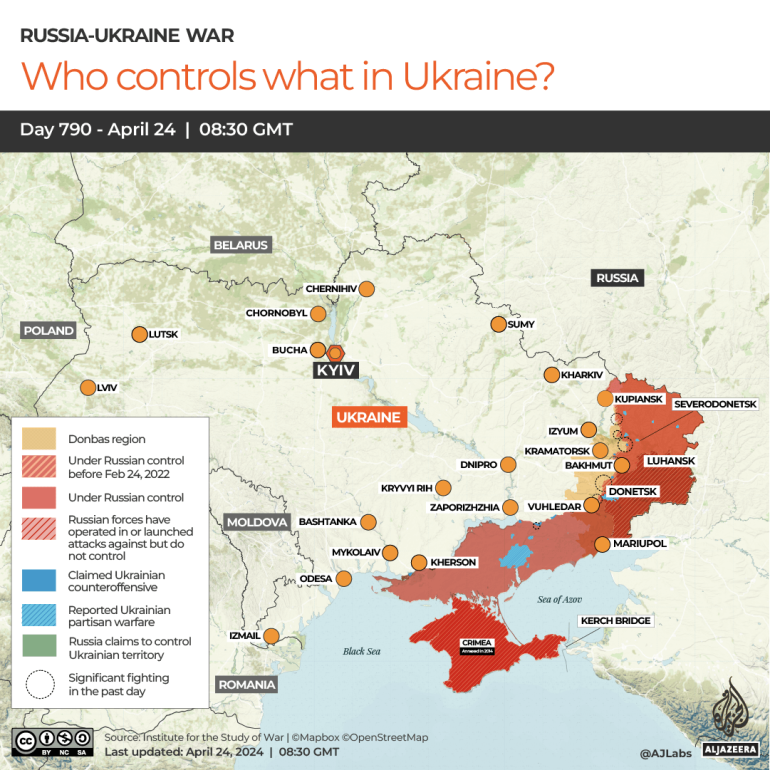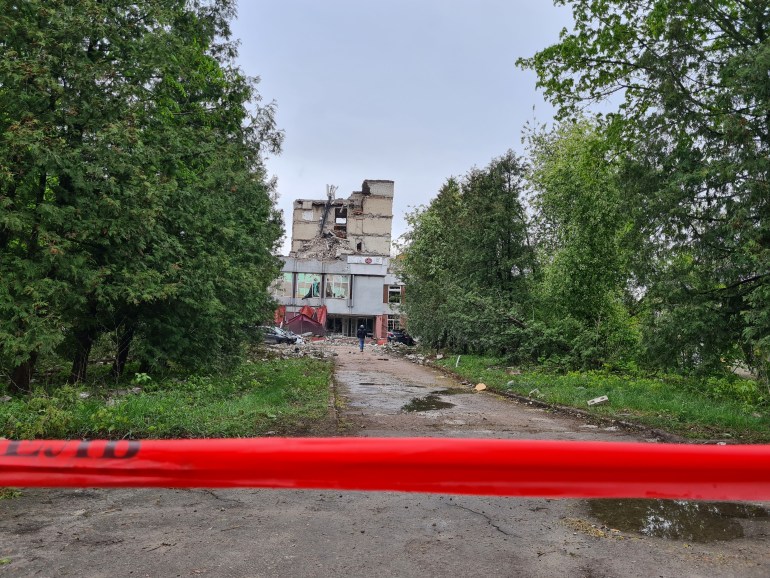Chernihiv, Ukraine – Tamara was pregnant when she had to hide for three weeks in the freezing basement of her home in Chernihiv, a city in northern Ukraine.
“When [Russian bomber] Planes were overhead, the only thing we could do was pray,” she told Al Jazeera, recalling the start of the war in February 2022 that devastated her city and forced two-thirds of its 300,000 residents to flee.
She experienced that horror again on April 17, when Russian missile attacks killed 18 people and injured dozens here.
“Why can’t the West understand that every day of delay means more deaths?” she said Saturday outside a gold-domed 17th-century church where a memorial service for the victims was about to begin.
She was referring to U.S. military aid, which has been stalled in the U.S. House of Representatives since October over objections from House Republicans allied with former President Donald Trump.
Later Saturday, the House of Representatives finally approved the $61 billion package — and millions of Ukrainians sighed with relief.
The bill includes $23 billion to replenish stockpiles of U.S.-made weapons and expand future military transfers.
Another $14 billion will be used to purchase advanced weapons directly from U.S. military suppliers, and $11 billion will be used to fund U.S. military operations in the region, train the Ukrainian military and strengthen intelligence cooperation between Kyiv and Washington used.
The $8 billion in non-military aid will, among other things, help President Volodymyr Zelensky’s government pay salaries.
A symbolic “alms”?
One of Ukraine’s top military experts said the package would not turn the tide of the war.
The aid could “improve the situation on the 1,000-kilometer front line,” said Lt. Gen. Ihor Romanenko, a former deputy chief of general staff of the Ukrainian Armed Forces.
But the aid looks like “a handout to show that we have not been forgotten, nothing more than that,” he told Al Jazeera.
“They’re always late, they’re putting on the brakes, they’re scared,” he said. “All of this is being done to catch up [with Russia]but wars are won by those who are ahead of the curve.”
The package includes NATO-standard anti-tank missiles and 155 mm artillery shells that could put an end to the desperate “shell hunger” of the inferior Ukrainian troops.
There are also missiles, armored vehicles and anti-aircraft ammunition.
But to move forward and win the war, rather than containing Russian forces, Ukraine needs longer-range missiles with advanced warheads, better air defense capabilities and F-16 fighter jets, Romanenko said.

In recent months, Russian bombers rained so-called “glide bombs” on Ukrainian positions on the Eastern Front, triggering the capture of the key stronghold of Avdiivka.
The bombs are equipped with wings and guidance systems, carry half a ton of explosives and can destroy once impregnable fortifications and hideouts.
“You survive a bomb attack and then collect the remains of your brothers in arms in a plastic bag,” a Ukrainian soldier stationed in Avdiivka told Al Jazeera.
Ukraine has long urged the West to provide F-16 aircraft that could shoot down and scare away Russian bombers.
Washington has refused to donate its own planes, while other NATO countries have pledged to supply up to 45 jets.
However, Kiev will not receive the first six players until July.

The White House also hesitated to provide another key weapon – the long-range missile known as the Army Tactical Missile System (ATACMS) – for fear that Kiev would use it to strike deep inside Russia.
Just in September, Ukraine received a batch of outdated ATACMS missiles and used them to attack two military bases in the Russian-occupied territories.
Newer ATACMS missiles with a range of up to 300 km (186 miles) have been secretly delivered to Ukraine, Reuters news agency reported on Wednesday.
The weapons hit a military airfield in Russian-annexed Crimea on April 17, destroying or severely damaging four advanced S-400 air defense systems and three radar stations, it said.
Help to replenish, but “not for an advance”
Other observers agreed that the aid package is aimed at keeping Ukraine on the defensive – and will not allow it to launch a counterattack to retake occupied territories.
The aid “surprisingly closely matches the needs of the Ukrainian military, which largely faces a shortage of air defense weapons of all kinds and also needs to replenish its arsenal of tank destroyers, anti-infantry landmines and other types of ammunition,” Germany’s Nikolay Mitrokhin said the University of Bremen told Al Jazeera.
“It is obviously needed to get infantry and other ground troops to the front, but not for an advance – otherwise the US would have given tanks,” he said.
Ukrainians who know firsthand about the needs of the Ukrainian military complain about the lack of weapons for a counteroffensive.
“It is important that the aid helps us not only contain but also fight the enemy on the territory of Ukraine [Russia] back to Ukraine’s 1991 borders,” Oleksandr Antybysh, who volunteers with the Take Back Our History group in Chernihiv, told Al Jazeera.
However, there could be a much more dangerous political trap for Ukraine.
By including the Ukraine package in a bill that also includes military aid for Israel and Taiwan, the US is showing the world that it puts Ukraine and Israel’s arch-enemies – Russia and Iran – on an equal footing with China, a Kiev-based analyst said.
“This is a major geopolitical blow for China,” Aleksey Kushch told Al Jazeera.
The approval of the bill followed a visit by US Secretary of State Antony Blinken to Beijing that began on Wednesday.
The U.S. has long called on China to stop allowing Russian companies to transact in yuan and export dual-use goods such as civilian drones, computer chips and machine tools that can be used in weapons manufacturing.
The pressure could force Beijing to seek closer ties with Moscow – and result in it receiving additional economic benefits from Moscow, which shifted its hydrocarbon exports eastward following Western sanctions over the Ukraine war.
“With trade turnover between Russia and China rising to $240 billion last year, the more the US pushes Beijing, the more rebates China receives from Russia for oil and gas,” Kushch said.
